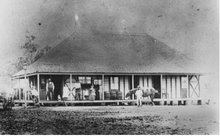We didn’t cut it down because of the flying foxes. Last week when I was checking the scientific name of our snowflake bush, I found my way to the Queensland Poisons Information Centre site. The snowflake bush is listed as a category 3 poison with its irritating oozing sap. I already knew of this, and the children know not to break off branches and to wash immediately if they get sap on them.
 White cedar is listed as a category one poison complete with a dramatic skull and cross-bones. Recommendation for category one plants is: “extremely toxic, has been known to cause injury, permanent disability, and in some cases, death. Do not plant. Removal and disposal of existing plants is strongly recommended.”
White cedar is listed as a category one poison complete with a dramatic skull and cross-bones. Recommendation for category one plants is: “extremely toxic, has been known to cause injury, permanent disability, and in some cases, death. Do not plant. Removal and disposal of existing plants is strongly recommended.”All parts of the plant are poisonous with symptoms of poisoning including nausea, vomiting, diarrhoea, lethargy, confusion, coma, seizures, and death. Apparently the leaves and seeds are natural insecticides and the bark is used in Mexico as a fish poison. I have since found out that it is officially listed as an exotic or “garden escapee” weed so I feel a bit better about its removal.
Sentence was pronounced and the tree sent to tree heaven. I still have to rake the yard to get all the fruit scattered by the flying foxes. Fortunately we have been nurturing a macadamia tree under its shadow for a few years now, so we have a head start on its replacement (if we can manage not to kill the macadamia.)
It set me to thinking though about how you would know what to eat if you were new to this area. The native lilly pilly has similarly attractive fruit which are safe to eat and quite tasty. They taste like tiny Asian wax apples. White cedar fruit are larger, shinier, much more fruitlike. Both fruits are eaten by birds and flying foxes without harm. Unless you had access to native knowledge, life in the colonies would have been dangerous in this and so many other ways.

No comments:
Post a Comment